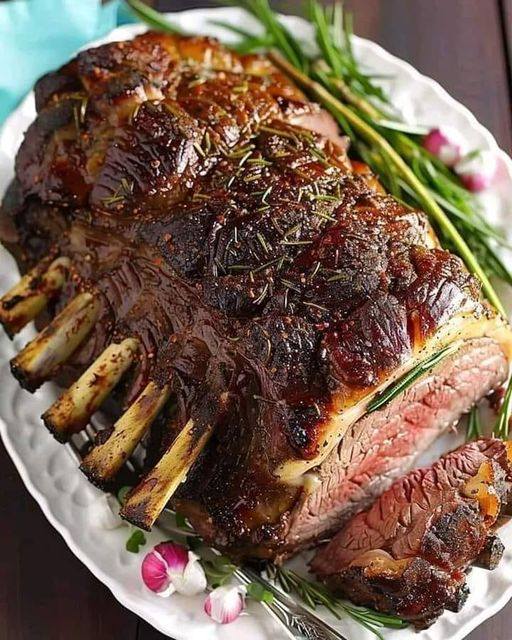ADVERTISEMENT
in a roasting pan. The bones act as a natural rack, lifting the meat off the bottom of the pan and allowing heat to circulate evenly. If you prefer, you can add beef broth or wine to the bottom of the roasting pan for extra flavor and moisture.
For Complete Cooking STEPS Please Head On Over To Next Page Or Open button (>) and don’t forget to SHARE with your Facebook friends
4. Roasting the Standing Rib Roast:
Place the roast in the preheated oven. Roast at 450°F (230°C) for the first 15 minutes to create a sear. Then, reduce the oven temperature to 325°F (165°C) and continue roasting for about 1.5 to 2 hours (for a 6-8 pound roast).
The key to a perfectly cooked standing rib roast is using a meat thermometer. For rare, aim for an internal temperature of 120°F (49°C), for medium-rare, 130°F (54°C), and for medium, 140°F (60°C). Keep in mind that the roast will continue to cook slightly after you remove it from the oven, so aim for the lower end of the desired temperature range.
5. Resting the Roast:
Once the roast reaches your desired temperature, remove it from the oven and let it rest, covered loosely with aluminum foil, for at least 20 minutes. This resting period allows the juices to redistribute throughout the meat, ensuring a tender and juicy roast.
6. Carving and Serving:
After the roast has rested, it’s time to carve! Slice between the ribs to create individual portions. You can either serve the roast with the ribs attached for a dramatic presentation or remove them before slicing, depending on your preference. Pair the roast with your favorite sides, like mashed potatoes, roasted vegetables, or a classic Yorkshire pudding, and enjoy a meal that’s sure to impress.
Serving Suggestions:
A standing rib roast pairs perfectly with a variety of side dishes. Here are some of our favorites:
- Garlic Mashed Potatoes: Creamy mashed potatoes with roasted garlic make a classic and comforting side for prime rib.
- Roasted Vegetables: Roasted carrots, parsnips, and Brussels sprouts add sweetness and color to the plate.
- Yorkshire Pudding: A British classic that’s ideal for soaking up the delicious juices from the roast.
- Gravy: Make a simple beef gravy using the pan drippings to serve alongside the roast.
Tips for Success:
- Bone-In vs. Boneless: A bone-in standing rib roast will provide more flavor and a better presentation, but a boneless roast is easier to carve. Both options are delicious, so choose based on your preference.
- Room Temperature Meat: Make sure to let your meat sit at room temperature for at least 2 hours before roasting. This ensures even cooking and prevents the meat from becoming tough.
- Don’t Overcook: It’s easy to overcook a standing rib roast. Use a meat thermometer to ensure you’re serving the roast at the perfect doneness.
- Resting Is Key: Allow the roast to rest before slicing. This simple step ensures juicy, tender meat.
Why You Should Try a Standing Rib Roast:
The Standing Rib Roast is the ultimate indulgence for anyone who loves a tender, flavorful cut of beef. Whether you’re preparing it for a holiday meal, a special celebration, or simply because you want to treat yourself to an unforgettable dinner, this roast is sure to be a crowd-pleaser. With a beautifully browned crust, juicy interior, and rich beef flavor, it’s a meal that will leave your guests talking for weeks!
Conclusion:
A Standing Rib Roast might seem like an intimidating dish to prepare, but with the right technique, it’s easier than you might think. The key is using quality ingredients, a meat thermometer for perfect doneness, and giving it time to rest so that the juices stay locked in. Once you master this recipe, you’ll be ready to serve up this show-stopping meal anytime you want to make a lasting impression.
